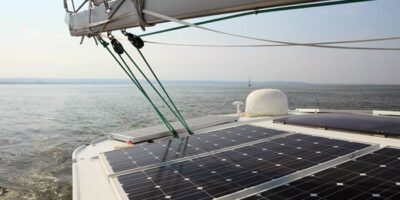Choosing A Marine Battery
There’s more to choosing the right battery for your boat than you may think. Making a smart decision now could save you big in the long run.
- January 25, 2024
So, the batteries on your boat have come to end of their life, and you need to buy new ones. But what should you choose? You would think that you could just walk into your local marine store and buy any battery that fits in the boat, right? Wrong. There’s more to equipping your boat with batteries than you might think. Batteries fall into one of two categories, deep cycle or starting. A cycle is the term given to a battery that discharges through use and is then bought back up to full charge again. As a rough guide, a light to medium duty battery will be good for about 200 to 300 cycles, while a heavy duty battery should easily be able double that amount of useful cycles with no ill effects.
A starting battery is the type you have on your car. The battery is there simply to crank the engine, then as soon the as the motor is running, all the electrical demands are satisfied by the alternator on the engine, which also recharges current drawn from the battery. The starting battery only has to give a big jolt of electrical power for a very short time.
A boat is very unlike a car with respect to the electrical demands placed on it. It may spend long periods at anchor, on a mooring or slip, with the engine not running, but you may still want to have the cabin lights on, run the stereo, perhaps even watch TV. All of these activities drain the batteries, but nothing is replenishing them until the engine is run, or the vessel is plugged into shore power and the battery charger turned on. So we need batteries that can meet the demand until they can be recharged. Deep cycle batteries fill the need in this regard. They are built with thicker plates than starting batteries, and can be discharged repeatedly down to about 50 percent of total capacity without damage.
The internal make up of each of these battery types is different, although you can’t tell that from the outside. Like all batteries, a starting battery has thin plates surrounded by an electrolyte. These thin plates are able to produce a large amount of amps over a short period of time. A deep cycle battery on the other hand, with its much thicker plates, is designed to have electricity drawn from it at a steady rate over a long period. A starting battery that is used for house loads will have a short life span, and if severely run down, may suffer from internal damage such as buckled plates, ruining the battery. Conversely, a deep cycle battery is a poor choice for engine starting, as it may lack the required short-term muscle to crank a cold engine.
Batteries come in range of sizes. Terms that you will often hear are group 24, 27, 31, 4D, and 8D. The group has nothing to do with the actual capacity of the battery, but merely relates to the physical size.
Another factor to consider is the actual battery capacity. Usually given as amps, short for amperes, or amp hours, a battery that is rated as 100 amp hours should be capable of delivering 5 amps for 20 hours, or 100 amps for one hour. This however is theoretical. No battery, regardless of the type, should be discharged at a rate greater than 50 percent of its rated total capacity, or permanent damage may result. Draw down a battery repeatedly below the 50 percent mark and the battery may have a reduced life span. Using this rule it a fully charged 100-amp battery in perfect condition will have a useful capacity of 50 amps, and even this reduces slightly as the battery ages.
Just to make things a little more confusing there are also several methods of constructing batteries. Up to this point we have been discussing traditional lead acid batteries, which have a fluid electrolyte that requires periodic topping up, but there are others.
In absorbed glass mat (AGM) batteries the electrolyte is contained within a fiberglass mat between the plates. These batteries, often called maintenance free, require no periodic topping up, and will not leak even if the case is cracked. They can even be mounted on their side if need be.
Gel batteries are also maintenance free but in this case the electrolyte is a jelly type solution, which unlike the AGM batteries will leak if the case is cracked. Both AGM and gel batteries cost considerably more than traditional types, but in the majority of cases accept a charge more readily than lead acid types, enabling them to be bought back to full potential more quickly.
Although cost is a consideration, this should be weighed against what the battery will be used for. Deep cycle, AGM, and gel batteries do cost substantially more than flooded types with thin plates. However, a cheaper battery from the local automotive store may have a much shorter lifespan aboard, need frequent replacement, and over the life span of the boat, actually cost more.
Mark Corke
Contributing Editor, BoatUS Magazine
About Vessel Vanguard
Vessel Vanguard is a leading marine safety and maintenance management software provider dedicated to revolutionizing the maritime industry. With a commitment to innovation and excellence, Vessel Vanguard delivers cutting-edge solutions to streamline operations and enhance vessel performance and safety.
Latest Industry Insights

Embracing E-Boating Efficiencies

Boat Fuel Systems

The Future of Boats & Boating

Yacht Navigation Light Inspection
View All of Our Industry Insights
Navigate maritime with the latest news, practical how-to guides, insightful analyses and more.
